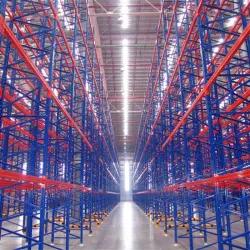Features and considerations when it comes to industrial storage racks
2024-04-07
Industrial storage racks are heavy-duty shelving systems designed to store and organize large quantities of goods, materials, and products in industrial, warehouse, manufacturing, or distribution settings. Here are some key features and considerations when it comes to industrial storage racks:
1. Material and Construction:
- Industrial storage racks are typically constructed from high-strength steel or aluminum to withstand heavy loads and rugged industrial environments.
- The shelving components, such as beams, uprights, and frames, are engineered for durability and structural integrity, often featuring welded or bolted connections for added stability.
- Corrosion-resistant coatings or finishes may be applied to the rack to protect against rust, moisture, and other environmental factors.
2. Design and Configuration:
- Industrial storage racks come in various designs and configurations to accommodate different storage needs and space constraints.
- Common types of industrial storage racks include pallet racks, cantilever racks, bulk storage racks, drive-in racks, and push-back racks, each designed for specific applications and storage requirements.
- The rack may be configured with adjustable shelves, beams, or arms to accommodate different sizes and types of goods, allowing for maximum storage flexibility and customization.
3. Weight Capacity:
- Industrial storage racks are designed to support heavy loads, often ranging from several hundred to several thousand pounds per shelf or level.
- The weight capacity of the rack is determined by factors such as the material strength, design configuration, and support mechanisms used in its construction.
- Manufacturers typically provide weight capacity ratings for their racks, allowing users to select the appropriate rack based on their specific storage needs and load requirements.
4. Accessibility and Space Optimization:
- Industrial storage racks are designed to maximize storage density and accessibility, allowing efficient use of available space while facilitating easy loading, unloading, and retrieval of goods.
- The rack may be configured with multiple levels of shelves or tiers, with aisles or passageways between rows to facilitate movement and navigation within the storage area.
- Some industrial storage racks feature roll-out or slide-out shelves, allowing users to access stored items from multiple sides or angles without the need for additional space clearance.
5. Safety Features:
- Industrial storage racks are equipped with safety features to ensure the safe and secure storage of goods and materials, as well as the protection of personnel and equipment.
- Horizontal crossbars, safety rails, or wire mesh panels may be installed along the sides and backs of the rack to prevent items from falling or shifting during loading and unloading operations.
- Load stops, pallet supports, or decking options may be used to stabilize and secure palletized loads, preventing them from tipping or sliding off the shelves.
6. Installation and Assembly:
- Industrial storage racks are typically modular in design, with easy-to-assemble components and minimal tools required for installation.
- The rack may be freestanding or bolted to the floor for stability, depending on the specific application and user preferences.
- Installation instructions and safety guidelines are provided by the manufacturer to ensure proper assembly and use of the rack in industrial environments.
Overall, industrial storage racks provide efficient and organized solutions for storing and managing large quantities of goods and materials in industrial, warehouse, and distribution facilities. By choosing a rack with the appropriate material, design, weight capacity, safety features, and configuration, users can optimize storage space, improve workflow efficiency, and enhance workplace safety.



